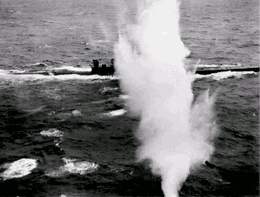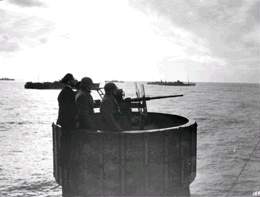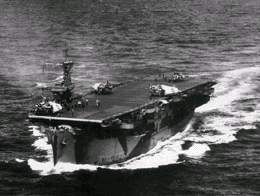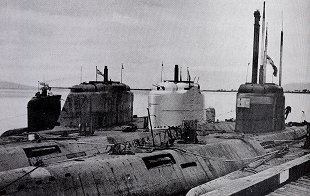
|
Battle of the Atlantic
The End for the U-Boats
The end drew steadily near for the U-boats. Everywhere that Donitz looked, his U-boat war was foundering. The Allies kept adding new escorts, developed new weapons and perfected the convoy system which easily defeated the wolf packs. Allied shipbuilding capacity continued at a rapid pace, and by this time it had become almost impossible for U-boats to keep up with the tonnage race.
Beginning June 1943, the U-boat force took another blow. In that month, the British Admiralty changed naval codes, and the German code breaking service, B-Dienst, which had been reading much of Allied traffic since February 1942 could no longer provide decrypts of Allied messages. This incalculable setback meant that BdU was deprived of valuable tactical information. Up to the end of the war, the Germans were not able to break the new Allied naval code. This seesaw battle of code breaking also saw the Allies decidedly triumphant when Bletchley Park penetrated the four wheel Enigma during the same month. The German situation at the Atlantic was open to Allied observers and the position of every U-boat was closely tracked on a daily basis.
The Allies were clearly winning the war and were becoming bolder in their approach. From intercepted communications, the Americans launched an offensive against the German U-tankers, which were still strategically scattered throughout the Atlantic. In that summer of 1943, American hunter-killer groups consisting of escort carriers and destroyers systematically located and destroyed the U-tankers, virtually eliminating them from the Atlantic. The destruction of the tankers was a strategic step forward. U-boats could no longer reach distant shores, and with the threat of these areas now neutralized, the Allies were free to concentrate their resources on areas still within range of the U-boats. The British were cautious that the sudden demise of the U-tankers would alert the Germans of their new found ability to intercept Enigma messages. Nevertheless, Donitz failed to realize that their communications had been compromised.

|

|
| A U-boat under aircraft attack. Note the falling depth charge on lower right of the photo. | Anti-aircraft armament aboard an Allied armed merchant. In the backgroud, a convoys steams unmolested into Europe. |
The German response was threefold - the development of new weapons, new devices and a new submarine design. In the field of weaponry, a new acoustic homing torpedo was introduced. The T5 or Zaunkonig was a specialized anti-escort torpedo which would home in on the propeller noise of surface ships. The later improved version (Zaunkonig II) could be fired from up to a depth of 50 meters. To defeat Allied aircraft, Flak U-boats were introduced in May 1943 and anti-aircraft armament on existing attack boats were upgraded. However, even with the improved anti-aircraft weaponry, U-boats were still very vulnerable to air-attack.
New devices were introduced to combat the effectiveness of Allied equipment. Radar decoys, such as the “Aphrodite” and “Thetis“ fooled Allied radar into thinking that a U-boat was present. This consisted of several strips of aluminum foil attached to a line or wooden pole that hovered just above the water. It was kept in place either by a float or balloon. The idea was to send Allied pilots on wild-goose chases and for U-boats to show up all over the Atlantic on Allied radar. Sonar decoys such a “BOLD” also entered service which would fool enemy sonar about the presence of an underwater U-boat. A new radar detector was developed to complement the now ineffective Metox. The NAXOS was more accurately tuned to Allied radar and could reliably detect radar signals up to five kilometers away. But the scientists’ main accomplishment was in the introduction of the Snorkel device. Originally developed by the Ducth Navy, this device allowed a submerged U-boat to draw in outside air via a tube which extended above the water. A U-boat could now run its powerful diesel engines or recharge its batteries while remaining safely submerged. However the snorkel was more of a defensive device and did nothing to contribute to a boat’s attack ability.
Finally, the greatest effort was in the development of a true submarine, instead of the mere submersibles of the U-boats. What Donitz desperately wanted was a vessel that could travel rapidly underwater, stay there for weeks and attack while submerged. Since the summer of 1942, German scientists had been researching on a new air-independent propulsion system, dubbed the Walter System. However, this propulsion system used hydrogen peroxide, a highly volatile material and a complex system of drives which might take years to perfect. The Walter system was not approved for construction, but from that project, a new development on an advanced prototype which would represent a new stage of submarine design was born.

|

|
| A US Bogue-class escort carrier. These support groups played a vital role in defeating the U-boat threat. | The revolutionary Elektroboat was Germany's gamble to restore the balance. It was capable of 26 knots underwater speed. |
Dubbed the “Elektroboat”, this would soon become the world’s first true submarine, capable of revolutionary underwater speeds, very long underwater endurance and the capability to attack completely blind while submerged. This suited Donitz’s requirements well and so promising were these designs that construction for all older types were cancelled, except for those already under construction and for a handful of others for specific purposes. All resources were to be given over to the production of the Type XXI and its smaller cousin, the Type XXIII. Concurrently, new prefabrication methods cut construction time almost in half, but even at that, no Elektroboat was expected to be ready for almost another year.
The reality was, Germany did not have another year. By June 1944, the Allies invaded France and forced U-boats stationed there to flee their French bases. Constant bombing raids on German dockyards disrupted power, railway lines and halted constructions. Many Elektroboats were sunk in harbor, some already completed and outgoing fitting out and some while undergoing training. Only two Type XXIs and eight Type XXIIIs had entered service. Given their limited deployment, these new revolutionary boats were quite successful and would have caused the Allies much problems. But there were never enough of these around to cause any real difference to the war.
In September 1943, Donitz renewed his attacks in the North Atlantic. Armed with new weapons, new devices and high expectations, the wolf packs commenced their attack against Allied convoys, but the entire effort collapsed under the sheer numbers of Allied escorts and aircraft. By the end of the 1943, more U-boats were being lost than Allied ships and through to spring of 1944, very few convoys were intercepted and none successfully attacked. Only once more, in the following of March, would U-boats sink more than 100,000 tons of shipping. The liberation of France forced U-boats to retreat to bases in Norway or the German North Sea coast, further shrinking their operational reach. As further testament, between June and August 1944, U-boats deployed against the Normandy invasion sank five escorts, twelve merchant ships and twelve landing craft, while losing twenty boats of their own. From then on, the situation for the U-boats was hopeless.
There was nothing the U-boats could do to save Germany. From the east, the Soviets marched on, while British and American troops closed from the west. On May 4th 1945 at 3.14pm, Donitz broadcasted his final message, “You have fought like lions. Unbeaten and unblemished, you lay down your arms after a heroic battle without equal”.
The surviving U-boats were ordered to cease hostilities and to sail to the nearest Allied harbor, flying a black flag for surrender. Instead of surrender, seven sailed to neutral ports, and 221 scuttled their craft.
Of the 1,155 U-boats Germany sent into combat, 725 had been sunk in the longest battle of the war. Lasting nearly six years, over 35,000 German sailors had put to sea, with 28,744 never returning – a death rate of 82 percent, the highest casualty rate of any armed forces of any conflict in the history of modern war. Yet in this appalling casualty rate, there was never any shortage of men to enlist in the U-boat service, and until the very last day, the men of the U-boat service stood ready to put to sea at a moments notice.



